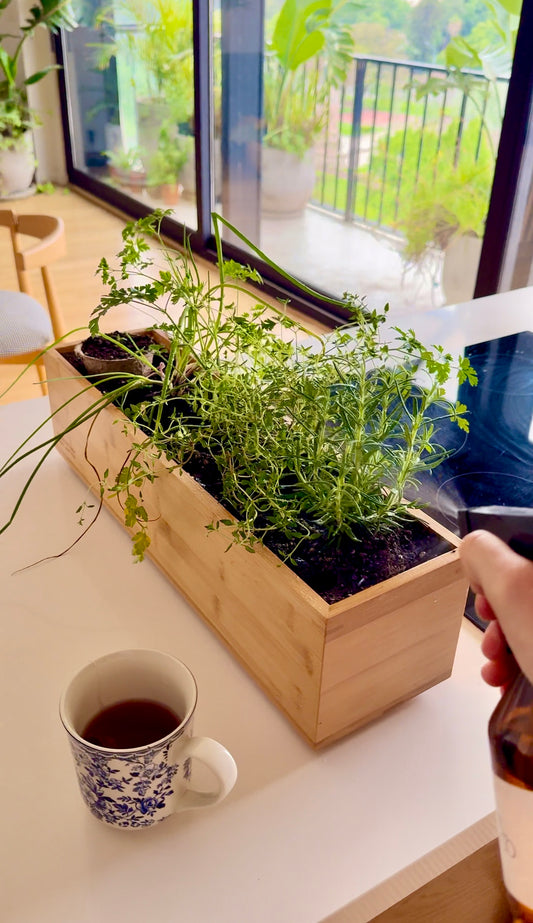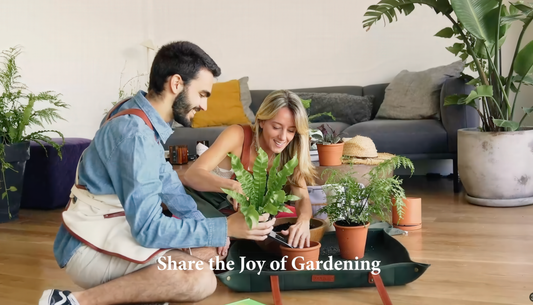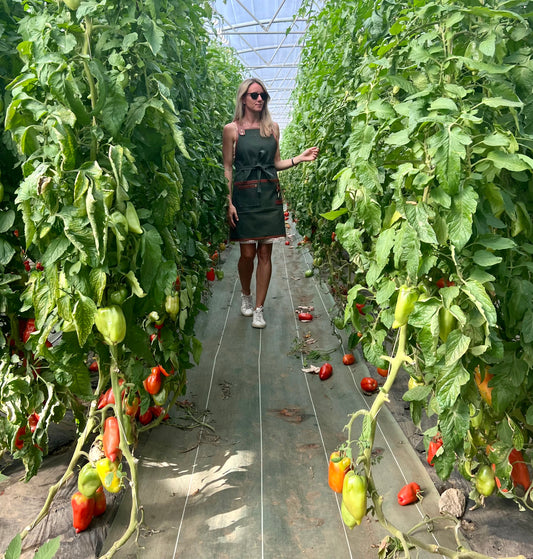A Look at Harvesting Peppers: Experience the boundless versatility of the Fleur Du Bien Apron.

Peppers are a staple ingredient in many dishes around the world, and their harvest season is always something to look forward to. Aside from being delicious and nutritious, peppers also come in different shapes, sizes, and colors - making them visually appealing as well.
Items required for successful pepper cultivation:
- Fleur Du Bien Apron: Wearing an apron while gardening can protect your clothing from getting dirty or stained.
- Garden tools: Depending on the size of your garden, you may need a shovel, rake, and hand trowel to prepare the soil and plant the peppers.
- Compost or well-rotted manure: These can be purchased from a garden center or made at home to improve the quality of your soil.
- Pepper seeds or young plants: Choose a variety of peppers that suit your taste and climate for the best results.
- Watering can or hose: Regular watering is essential for pepper plants, so make sure you have a way to water them easily.
- Mulch: As mentioned before, mulching can help retain moisture and prevent weeds from growing around your pepper plants.
- Support structures: Depending on the type of peppers you are growing, you may need stakes, cages, or trellises to support the plants as they grow taller and produce fruits.
- Sunscreen and gardening gloves: Protecting yourself from the sun's harmful rays and potential irritants while gardening is important for your health.
- Organic fertilizer: If your soil lacks nutrients, you may need to add an organic fertilizer to help your peppers grow healthy and strong.
- Pruning shears: As the pepper plants grow, they may need pruning to promote bushier growth and prevent overcrowding.
- Harvesting basket or container: When the peppers are ripe and ready to be picked, having a basket or container on hand can make it easier to gather them.
- A positive attitude and patience: Growing peppers takes time and effort, but the end result is worth it. So stay positive and patient throughout the process!
By following these steps and having the necessary items on hand, you can successfully
List of the steps for planting peppers:
- Choose a suitable location: Peppers require plenty of sunlight and well-drained soil to thrive. So, select an area in your garden with full sun exposure and soil that is not too compact.
- Prepare the soil: Before planting peppers, it is important to prepare the soil by tilling it and adding compost or well-rotted manure to enrich it with nutrients.
- Purchase healthy pepper plants: You can either start peppers from seeds or purchase young plants from a nursery. Make sure to choose healthy and disease-free plants for the best harvest.
- Dig planting holes: Pepper plants should be spaced about 18 inches apart, so dig holes that are slightly wider than the root ball of the plant.
- Plant the peppers: Gently remove the plants from their containers and place them in the planting holes, making sure to cover the root ball with soil.
- Water thoroughly: After planting, water the peppers deeply to help settle the soil and provide moisture for the roots to establish.
- Mulch around the plants: Adding a layer of organic mulch such as straw or shredded leaves around the base of the plants can help retain moisture and suppress weed growth.
- Provide support: Depending on the type of peppers you are growing, you may need to provide support for the plants as they grow taller, such as using stakes or tomato cages

Let's delve deeper into the subject and provide a more comprehensive explanation:
Planting peppers entails a careful preparation and a keen attention to detail. Firstly, the ideal time for planting pepper seeds is about 8-10 weeks before the last spring frost. Essential requirements include well-drained soil with a pH range of 6.0-6.8, ample sunlight, and consistent watering.
When it comes to harvesting, peppers are typically ready 60-90 days from planting. The exact time will vary depending on the variety of pepper. A ripe pepper will be firm to the touch and its color will be vibrant and consistent.
Is it possible to engage in planting and harvesting throughout the year, regardless of the season?
Yes, it's possible to harvest peppers if you want to harvest in October depending on the specific climate and growing conditions. Peppers are typically ready for harvesting 60-90 days after planting, so if you plant your seeds in late June or early July, you can expect to harvest them in October. However, keep an eye on the weather as cold temperatures can damage pepper plants and hinder their growth. If you live in an area with colder temperatures, it may be best to harvest your peppers before October. Ultimately, the exact time for harvesting will vary depending on your specific location and growing conditions. Happy gardening!
What are the top seed varieties for growing peppers?
There are many types of pepper seeds available, each with their unique qualities. Some popular varieties include bell peppers, jalapenos, cayenne peppers, and habaneros. When selecting the best seeds for your garden, it's important to consider factors such as the climate in your area, your personal preferences in terms of taste and heat level, and the specific growing conditions required for each type of pepper. Researching and experimenting with different types of pepper seeds can be a fun and rewarding experience. Whatever you choose, make sure to properly care for your plants and enjoy the flavorful fruits of your labor.
What is the proper way to sow pepper seeds?
Once you have selected the best pepper seeds for your garden, it's time to plant them. Start by filling a seed tray or small pots with a good quality potting mix and lightly water the soil. Place 1-2 seeds in each pot and cover them with a thin layer of soil. Keep the soil moist but not overly wet until the seeds germinate in about 7-14 days. Once the seedlings have grown to about 3 inches tall, they can be transplanted into a larger pot or directly into your garden bed. Make sure to provide adequate spacing between each plant, as peppers need room to grow and thrive.
Water requirements at various stages of the pepper plant's growth:
As mentioned before, peppers require consistent watering to grow and thrive. During the initial growth stage of pepper plants, it's important to keep the soil moist but not overly wet. This will help with seed germination and early root development. Once the seedlings have been transplanted into a larger pot or garden bed, they will require regular watering to establish strong roots. As the pepper plants continue to grow and produce fruit, it's important to monitor the soil moisture levels and water accordingly. Generally, peppers need about 1-2 inches of water per week, either through rainfall or manual watering. However, be careful not to overwater as this can lead to root rot and other issues. A good rule of thumb is to check the top inch of soil and water when it feels dry to the touch. With proper watering, your pepper plants will thrive and produce a bountiful harvest.
How can I determine if the seeds and plants require water or if I have overwatered them?
It's important to regularly check the soil moisture levels to determine when and how much to water your pepper plants. Overwatering can lead to root rot and other issues, so it's crucial to avoid this problem. One way to check if your plants need water is by digging a small hole in the soil near the base of the plant. If the soil is moist about an inch below the surface, then your plants likely don't need watering yet. However, if the soil is dry, it's time to water. Additionally, overwatered plants may start to wilt or show signs of yellowing leaves. If you notice these symptoms, reduce the amount of watering and make sure the soil has proper drainage to prevent future issues.
Why I need to mulch my pepper plants: Mulching around pepper plants can provide many benefits. First, it helps retain moisture in the soil and reduces the need for frequent watering. This is especially helpful during hot and dry weather conditions. Mulch also helps suppress weed growth, which can compete with your pepper plants for nutrients and water. Additionally, organic mulch such as straw or shredded leaves can break down over time and enrich the soil with nutrients, improving overall plant health. Mulching is a simple and effective way to promote healthy growth and a successful harvest for your pepper plants.
Where can I find mulch?
You can purchase organic mulch at most gardening stores or home improvement centers. Alternatively, you can create your own by shredding dry leaves or using grass clippings from your lawn (as long as they have not been treated with chemicals). Another option is to use compost from a backyard compost pile as mulch for your pepper plants. Whichever method you choose, make sure to apply a layer of mulch around the base of your pepper plants, taking care not to cover the stem. This will help retain moisture and suppress weed growth, promoting healthy and robust pepper plants.
How can I support my pepper plants as they grow?
Depending on the type of peppers you are growing, you may need to provide support for your plants as they continue to grow taller. This is especially important for varieties such as bell peppers and poblano peppers, which can produce heavy fruit that may weigh down the branches. To support your pepper plants, you can use stakes or tomato cages. Place the stake or cage around the plant and gently tie any drooping branches to it using soft garden twine or fabric ties. This will help keep your pepper plants upright and prevent damage to the plant or its fruit. With proper support, your pepper plants can continue to grow tall and produce a plentiful harvest.
What are alternative methods for preventing pests or insects in my plants without relying on fertilizers?
There are several natural and safe methods for preventing pests or insects in your pepper plants without relying on fertilizers. One effective method is companion planting, where you plant pest-repelling herbs such as basil, rosemary, or mint alongside your pepper plants. These herbs have strong scents that can deter pests from attacking your peppers. Another option is to use homemade insecticidal soap, which can be made by mixing liquid soap with water and spraying it on your plants. Additionally, you can also introduce beneficial insects such as ladybugs, lacewings, or praying mantis to your garden as they feed on pests that may harm your pepper plants. These methods are not only natural and safe but also help maintain a healthy ecosystem in your garden.
How can I determine when they are ready to be harvested?
As mentioned earlier, peppers are typically ready to be harvested 60-90 days after planting. However, there are a few ways to determine if your peppers are ready for picking. Firstly, look at the color of the pepper - it should be vibrant and consistent throughout. Next, gently squeeze the pepper - a ripe pepper will be firm to the touch. Additionally, you can also check the size of the pepper - most varieties will grow to their full size before reaching maturity. Lastly, if you are growing hot peppers, you can taste a small piece to determine its level of heat. Remember, it's always better to let peppers fully ripen on the plant for maximum flavor and nutrition. Happy harvesting!
In addition to serving as a useful tool for gardening, the Fleur du Bien apron can also serve as a fashionable accessory in other settings. Its unique design and high-quality materials make it a versatile piece to wear while cooking, crafting, or even hosting gatherings. This apron is sure to impress with its intricate floral pattern and comfortable fit. Whether you are showcasing your skills in the kitchen or simply adding a touch of elegance to your everyday tasks, the Fleur du Bien apron is a must-have for anyone looking for a stylish and practical apron. So why not add it to your collection today and elevate your gardening and hosting game? So don't hesitate, get yours now!
Moreover, peppers are not only delicious but also packed with nutrients. They are a great source of vitamins A and C, as well as potassium, magnesium, and dietary fiber. Adding peppers to your diet can have numerous health benefits, such as boosting your immune system, improving eye health, and reducing inflammation.
Lastly, growing peppers is not only rewarding in terms of the delicious produce it yields but also in terms of the satisfaction and joy it can bring. Seeing your hard work come to fruition and enjoying the fruits of your labor is a truly fulfilling experience. So why not give it a try and start growing your own peppers today? With proper care and attention, you will soon have an abundance of flavorful peppers to enjoy in various dishes. Happy gardening!

Is it possible to cultivate plants indoors?
Yes, it is possible to grow peppers indoors as long as you provide them with enough light and warmth. You can start the seeds indoors in early spring and then transfer the plants outside once the weather warms up. Alternatively, you can also keep your pepper plants inside throughout their entire growing season by using grow lights. Just make sure to provide them with at least 8 hours of light per day and maintain a temperature between 70-80 degrees Fahrenheit. With the right care, you can successfully grow peppers indoors and enjoy fresh produce throughout the year. Ventilation is crucial
Ventilation is crucial for indoor pepper plants because it helps to circulate air and prevent the buildup of moisture, which can lead to fungal diseases. Proper ventilation also allows carbon dioxide (CO2) to enter the plant, which is essential for photosynthesis. Without enough CO2, plants cannot produce energy and will not grow properly. Additionally, good ventilation can help regulate temperature and humidity levels, creating a healthier environment for your plants to thrive. Some ways to achieve proper ventilation include using fans, opening windows or vents, and avoiding overcrowding of plants. Keep these factors in mind when growing peppers indoors for the best results.
In summary, planting and harvesting peppers requires careful planning and attention, but the end result is worth it. And with the Fleur du Bien apron, your gardening experience can be both functional and stylish. So whether you're growing peppers or simply looking for a versatile and fashionable apron, don't forget to add the Fleur du Bien apron to your collection. Happy harvesting! In addition to serving as a useful tool for gardening, the Fleur du Bien apron can also serve as a fashionable accessory in other settings. Its unique design and high-quality materials make it a versatile piece to wear while cooking, crafting, or even hosting gatherings. This apron is sure to impress with its intricate floral pattern and comfortable fit. Whether you are showcasing your skills in the kitchen or simply adding a touch of elegance to your everyday tasks, the Fleur du Bien apron is a must-have for anyone looking for a stylish and practical apron. So why not add it to your collection today and elevate your gardening and hosting game?
Why the Fleur du Bien apron is the ultimate choice for both planting and harvesting?
The Fleur du Bien apron is not only a functional tool for gardening, but also a fashion statement. Its unique design and high-quality materials make it the ultimate choice for both planting and harvesting peppers. Not only does it protect your clothes from dirt and stains, but it also adds a touch of elegance to your gardening attire.
Crafted with the finest 100% canvas and genuine leather, this backpack boasts ample pockets and adjustable straps, catering to all sizes.





